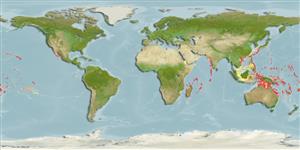Codium edule P.C. Silva
Branched sea cushion| Native range | All suitable habitat | Point map | Year 2050 |

|
| This map was computer-generated and has not yet been reviewed. |
| Codium edule AquaMaps Data sources: GBIF OBIS |
Google image | No image available for this species;
drawing shows typical species in Codiaceae.
Classification / Names आम नाम | उपशब्द | CoL | ITIS | WoRMS
Bryopsidophyceae | Bryopsidales | Codiaceae
Environment: milieu / climate zone / गहराई सीमा / distribution range पारिस्थितिकी
; गहराई सीमा 2 - 48 m (संदर्भ 80758). Tropical
Distribution देश | ऐफ ऐ ओ क्षेत्र | Ecosystems | संयोग | भूमिका
Indian Ocean: in Maldives; Pacific Ocean: from Taiwan to Papua New Guinea, including Spermonde Archipelago, Indonesia and Federated States of Micronesia, east to the Hawaiian Islands.
Length at first maturity / आकार / Weight / Age
परिपक्व अवधि: Lm ? range ? - ? cm
Short description आकृति विज्ञान
Life cycle and mating behavior परिपक्व अवधि | पुनरुत्पत्ति | मछलीऔ का अंडे देना | Eggs | Fecundity | Larvae
Main reference
संदर्भ | संयोजक | सहयोगीयो
Guiry, M.D. and G.M. Guiry 2009 AlgaeBase. World-wide electronic publication, National University of Ireland, Galway. http://www.algaebase.org; searched on 14 April 2009. (संदर्भ 80701)
IUCN Red List Status
(संदर्भ 130435: Version 2025-1)
CITES status (संदर्भ 108899)
CMS (संदर्भ 116361)
Threat to humans
Human uses
मात्स्यिकी: व्यापारिक
| FishSource |
साधन
अधिक जानकारी
संघटक आहार
आहार खपत
परभक्षी
Max. ages / sizes
Length-weight rel.
Length-length rel.
Length-frequencies
Mass conversion
बहुतायत
परिपक्व अवधि
Fecundity
मछलीऔ का अंडे देना
Eggs
Egg development
Larvae
इंटरनेट स्रोत
BHL | BOLD Systems | CISTI | DiscoverLife | FAO(Publication : search) | Fishipedia | GenBank (genome, nucleotide) | GloBI | Gomexsi | Google Books | Google Scholar | Google | PubMed | AlgaeBase | Tree of Life | Wikipedia (Go, खोज) | Zoological Record



